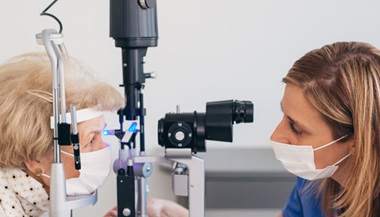Retinal Detachment
Featured Expert
There are several types of retinal detachment, which if left untreated, could create lasting vision loss.
Adrienne Williams Scott, M.D., Chief, Wilmer Eye Institute - Bel Air, explains the condition and treatment for retinal detachment.
What is a retinal detachment?
A retinal detachment occurs when the retina, which is the thin nerve tissue that lines the inside of the eye and is critical for sight, separates from its normal position.
Detached Retina Symptoms
A person experiencing a retinal detachment may notice:
- Abrupt onset of floaters (clumping of the vitreous gel inside the eye, which may appear as spots in the vision)
- Flashing lights
- Loss of peripheral vision, which can be compared to a curtain covering a portion of the vision.
Very rarely, a retinal detachment may not show any symptoms and is found during a routine dilated retinal exam.
Types of Retinal Detachment
There are several types of retinal detachments:
Rhegmatogenous Retinal Detachment
Rhegmatogenous retinal detachment is the most common type of detachment, and may occur as the vitreous gel pulls on the retina, causing a tear. Risk factors can include the following:
- High myopia (nearsightedness)
- Eye trauma
- History of cataract surgery
- Age
- Family history
- History of retinal tear or detachment in the other eye
Tractional Retinal Detachment
Various conditions can cause abnormal retinal blood vessels to grow. These abnormal vessels can lead to scar tissue formation, which can pull on the retina and separate the retina from the back wall of the eye, causing tractional retinal detachment. Another form of tractional detachment occurs when subretinal fluid, caused by scar tissue, gathers on the surface of the retina and lifts the retina. This can be caused by the following:
- Proliferative diabetic retinopathy
- Inflammatory or infectious conditions
- Retinopathy of prematurity (ROP)
- Sickle cell retinopathy
- Proliferative vitreoretinopathy
Exudative Retinal Detachment
Exudative retinal detachment happens when an accumulation of fluid under the retina separates the retinal layers. There are no associated retinal tears. This can be caused by the following:
- Uncontrolled hypertension
- Preeclampsia in pregnant women
- Age-related macular degeneration
- Ocular tumors
- Coats disease
- Panuveitis (various inflammatory conditions that can affect the eye, such as posterior scleritis)
Retinal Detachment Treatment
Treatment is based on the underlying cause and the type of retinal detachment. Retinal detachment may require urgent surgery, which may include laser treatment or cryotherapy (freezing therapy). Early intervention is important to achieve the best outcomes for optimal vision. Retinal detachment should be treated as soon as symptoms appear, so it is important to seek care with an eye care provider promptly if someone develops symptoms consistent with retinal detachment. Prompt referral to a retina specialist for evaluation and treatment may be necessary.







